The Razer Edge Review
by Vivek Gowri on March 28, 2013 11:00 AM EST- Posted in
- Tablets
- Mobile
- Razer
- Razer Edge
Performance
Now for the good parts. We’re actually pretty familiar with the computing platform behind the Edge. The ultra-low voltage IVB parts are commonly found in ultrabooks and are some of the AT mobile team’s favorite mobile processors right now. I’m not the only one, Dustin just rhapsodized about the ULV Core i5s in his review of the updated Dell XPS 13 last week. The usable performance and reasonable power draw on offer are just that fantastic, and these CPUs really represent the sweet spot of the market right now. I’m not sure that the additional CPU headroom of the i7s is really necessary or worth the additional cost; the 100-200MHz clock speed bumps are pretty incremental. The only really compelling thing about the i7 SKUs is their ability to hit 3.0-3.1GHz on Turbo, a solid 400MHz higher than the corresponding i5 parts.
The other thing is that I’m seeing a lot of cases where there will be two SKUs on offer – one with an i5, 4GB RAM, and a 64GB/128GB SSD, and then a high end one that offers spec bumps across the board – i7, 8GB, and 128GB/256GB. We’re moving away from the early 2000s Dell/HP/Gateway-era of pick your component computing, so the decision between i5 and i7 chips might actually be hinge on the rest of the package, as is the case with the Edge.
Anyways, that’s diverging a bit. We’re very familiar with both of the CPUs used by the Edge from various ultrabooks; in particular, the i5-3317U is the heart of my trusty ASUS Zenbook Prime and I just recently looked at the i7-3517U in my review of the Vizio CT15. The i7-3517U has a base clock speed of 1.9GHz and a max turbo of 3.0GHz, along with HD 4000 onboard graphics (350MHz base clock, 1.15GHz max). It performs roughly where we’d expect, and I’d also like to highlight the relative lack of differences between the i5 and i7 ULV SKUs here.
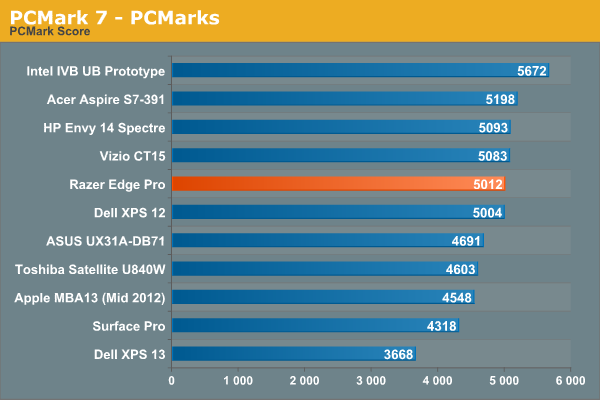
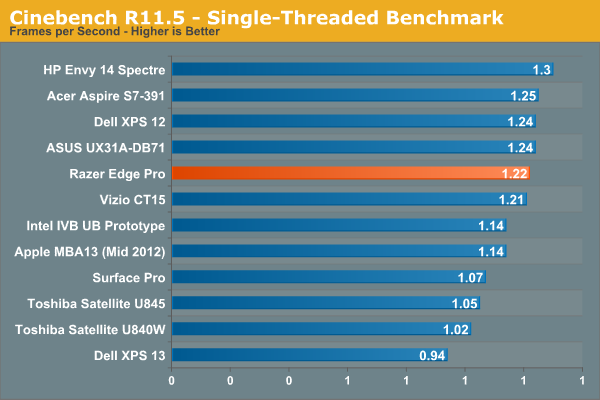
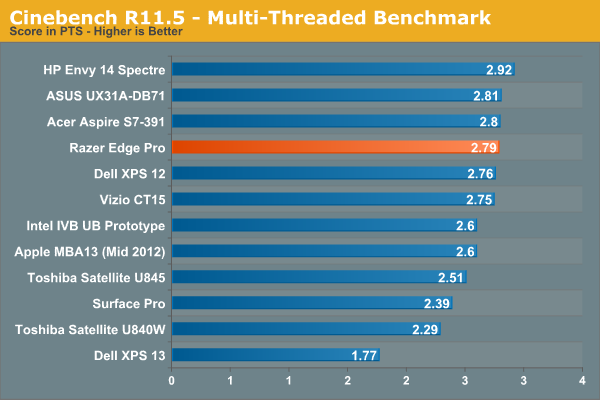
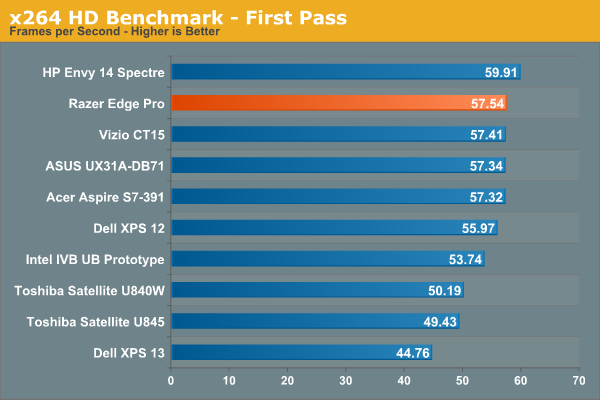
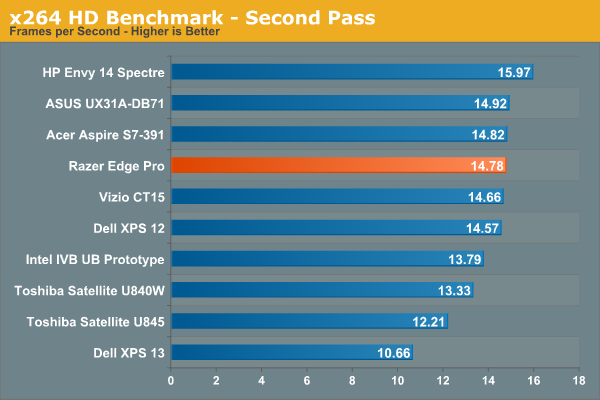

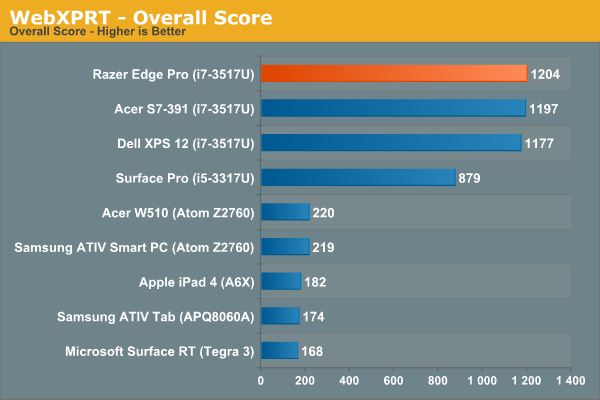
Graphics Performance
Nvidia’s mobile GPU heirarchy can get very, very convoluted, particularly at the low end, with a mix of new, old, and gap-bridging parts all under the same name. As such, there are many variants of GT 640M and GT 640M LE, with a mix of SKUs spanning the 28nm Kepler, 40nm Fermi, and 28nm die-shrunken Fermi cores. An interesting and related side-note: a few days ago, Anand asked the mobile team if we had seen any Kepler-based GT 630M notebooks. It took a bit of searching, but eventually it was determined that none of the GT 630M SKUs are actually Kepler based, only 28nm and 40nm variants of the Fermi core. When the lineups are so jumbled that even we can’t keep track of them, there’s something wrong. Why are some GT 640Ms so slow, while others are nearly equal to the DDR3 GT 650M? Why are there still 40nm GeForce 600M parts? I wish Nvidia could simplify and streamline their mobile GPU lineup, it’d make our lives easier as well as being a lot more transparent for consumers.
The GT 640M LE in the Edge is thankfully a Kepler part, so a 28nm GK107 core with 384 cores, 16 ROPs, and 32 TMUs, just like all Keplers from the GTX 660M on down. This is the absolute bottom of the range, so it has the slowest memory configuration (900MHz DDR3) and a 500MHz core clock, with boost up to 570MHz. The next big hardware jump comes with GDDR5 VRAM in the GT 650M, and a combination of clock speeds and GPU boost make up the differences between SKUs.
The 1366x768 panel comes into play here – Kepler, even at 500MHz, is more than capable of pushing 768p displays at high settings in modern games. High quality textures really start to tax the slower memory in the low-end Kepler cards as you increase resolution, so even with higher clock speeds, 1080p gaming will be non-ideal at best and downright bad at worst. Don’t expect much to be playable, as even the DDR3 variant of the GT 650M basically failed the 1080p portion of our gaming tests. The GDDR5 GT 650M and the GTX 660M (which comes in GDDR5 form only) do better here, but there’s a pretty substantial gap between those two chips and the rest of the GK107 mobile parts at 1080p.
We haven’t yet finalized our 2013 Gaming test suite, so I just ran our 2012 test suite. I did almost all of my testing on the road, sans access to 1080p displays, so I only have 1366x768 gaming results (that’s our value gaming suite, which runs medium detail settings at 768p). I also ran at high detail settings, to see what kind of differences there would be. Once our new suite is finalized, I’ll update with results at 1600x900 and 1080p.
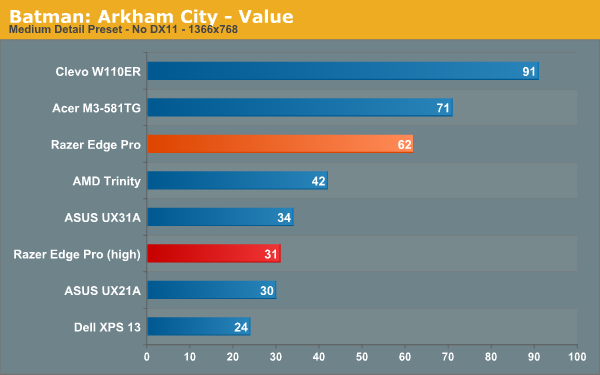
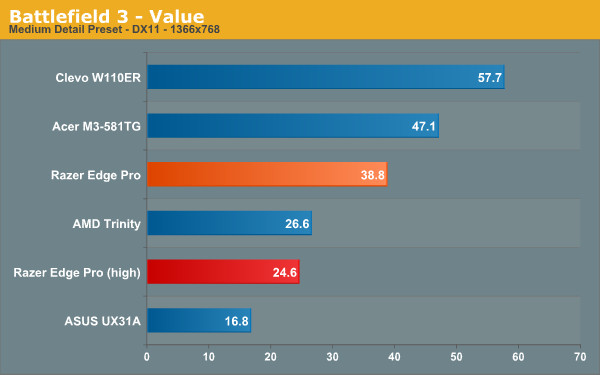
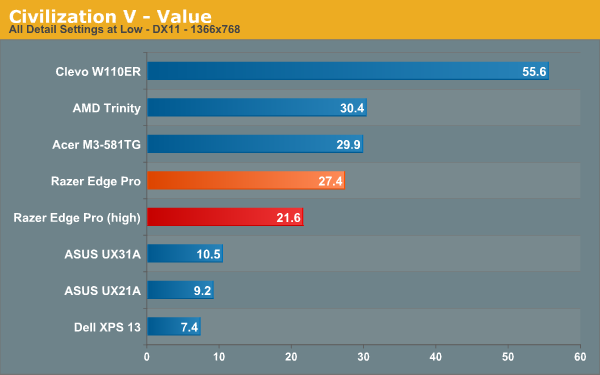
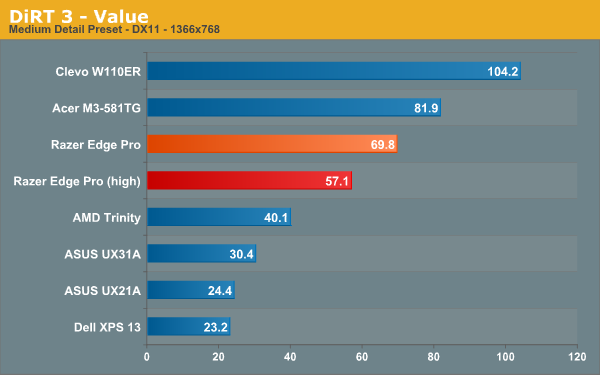

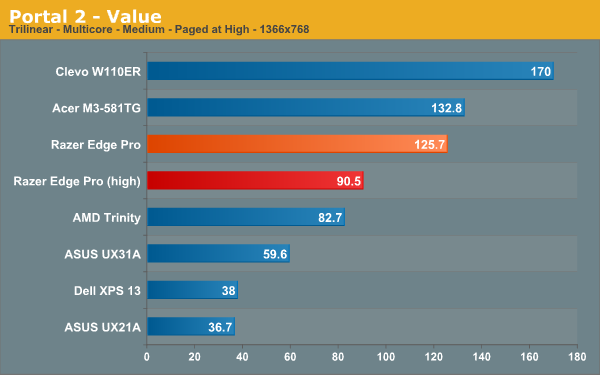
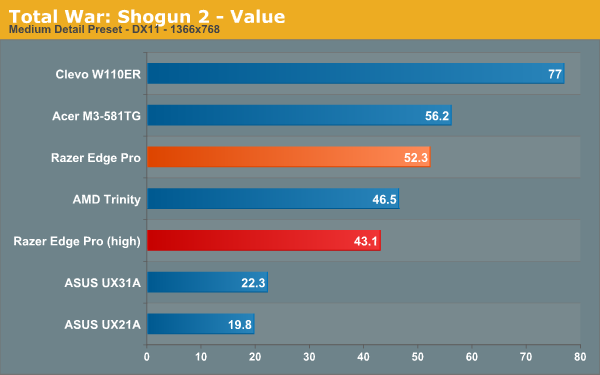
The Edge does pretty well, honestly – Kepler is a great mobile GPU, even clocked so low. At high settings, almost everything was playable, except for Battlefield 3 and Civ 5. I think Civ 5 is CPU limited on the Edge, while BF3 is one of the more strenuous games we test, so both of those were expected. Lower the settings to medium, and pretty much everything is playable.
The higher clock speeds of the GT 650M (DDR3) in the Clevo W110ER really make themselves felt, with substantially better gaming performance than the Edge throughout our benchmark suite. For a comparison with Surface Pro and the other IVB tablets, look at the ASUS Zenbook Primes - the UX31A with the 1.15GHz HD 4000 (i7-3517U) and the UX21A with the same HD 4000 clocked at 1.05GHz (i5-3317U). There's a small performance delta between the two due to the maximum frequency difference, but either way, HD 4000 seriously struggles to be playable in most of our benchmarks unless you lower either the resolution or detail settings. Again, Kepler at 500MHz is still a pretty capable card at 1366x768, so concern over frame rates is probably a moot one unless you’re gaming on an external display.










89 Comments
View All Comments
Blibbax - Thursday, March 28, 2013 - link
"would be awkward or impossible to play PC games are no longer so"Where can you use this that you couldn't use a similar sized laptop, though? This is what I don't get about tablets in general.
jamyryals - Thursday, March 28, 2013 - link
Many, many people disagree with you about tablets.freedom4556 - Thursday, March 28, 2013 - link
Think about it in terms of gaming though (as in, with a mouse or gamepad). Many, many people with tablets only play Angry Birds, Fruit Ninja, and Cut the Rope.A5 - Thursday, March 28, 2013 - link
That doesn't mean those are the only games on the platform. That's like saying PC gaming is worthless because most people only play The Sims or WoW.freedom4556 - Thursday, March 28, 2013 - link
That's not what I said, though. The original comment was "why a tablet when a laptop goes everywhere it does without the compromises?" The reply was many disagree with that (implying tablet sales were an indicator of gamers choosing tablets.) My reply was meant to say that real gaming wasn't happening on those tablets, and as such didn't indicate that gamers were ok with the compromises. I don't personally believe the the battery life, performance and cost are worth the "gaming tablet" concept, but then I don't like playing games on PC with the Xbox 360 controller. I prefer the wider range of motion and larger key count of a mouse+keyboard.Netscorer - Saturday, March 30, 2013 - link
His point is that tablets excel in touch-based games and activities. Once you start playing regular PC games that do not use touch, the whole advantage of a tablet compared to a laptop becomes iffy. Add enormous weight and short battery life and I, frankly, too do not see a point in this hybrid.VivekGowri - Friday, March 29, 2013 - link
Take a laptop - small, large, anything - and try to play an FPS or a racing game while riding the bus or subway. Or sit on your couch and try. It's somewhere between difficult and impossible to do, even if you use a touchpad and not an external mouse.The Edge works like a massive Gameboy Advance or PSP - just hold the controllers and go from there. It's closer to a portable console in experience than a notebook PC, even if it has PC silicon inside.
kyuu - Friday, March 29, 2013 - link
Plug in an Xbox controller, or use a wireless one. Heck, I believe you can connect a PS3 controller via bluetooth as well. I think you could play an FPS or racing game on a laptop fairly well that way.RoninX - Thursday, March 28, 2013 - link
Great review.Vivek, I have a Razer Edge Pro on pre-order, and I was wondering what you used to carry it around on airline flights. Is there a particular type of bag or case that works well to carry the Edge while docked with the gamepad? (Preferably one that's easy to pull out mid-flight.)
Thanks!
VivekGowri - Friday, March 29, 2013 - link
I just put it in my 17" notebook backpack (High Sierra Elite, $30 at Costco). You'll need at least a 15" backpack to fit it, the dimensions with the gamepad controller attached are roughly 15.9x7.7x1.3" - the width is about an inch and a half more than then MBP15, but only .75" more than the Dell XPS15z so your mileage may vary. 17" notebook bags hold it with ease though.